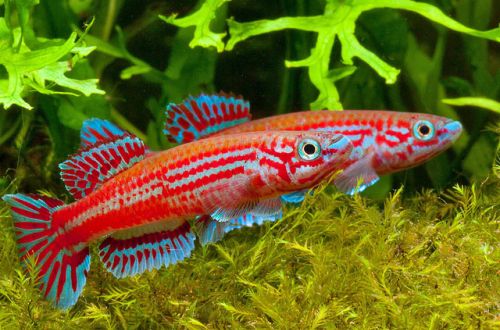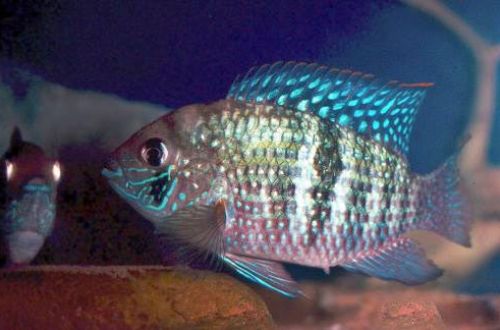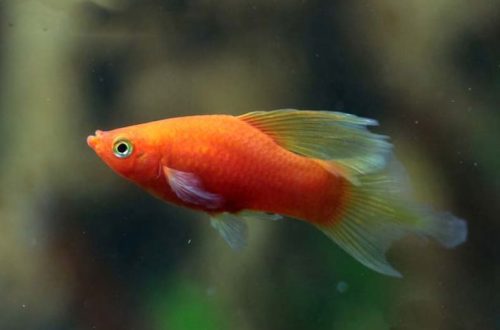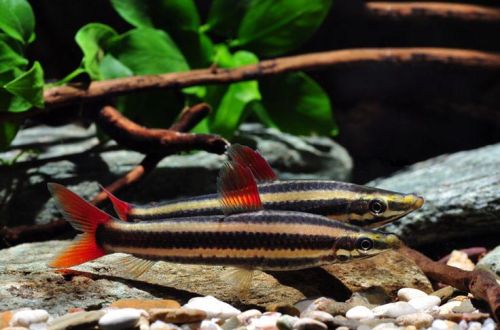
Afiosemion Ogove
Aphiosemion Ogowe, scientific name Aphyosemion ogoense, belongs to the Nothobranchiidae family. A bright original fish, despite its relatively simple content and unpretentiousness, is not often found on sale. This is due to the complexity of breeding, so not all aquarists have the desire to do this. Fish are available from professional breeders and large retail chains. In small pet stores and in the “bird market” you will not be able to find them.

Contents
Habitat
The homeland of this species is Equatorial Africa, the territory of the modern Republic of the Congo. The fish is found in small rivers flowing in the rainforest canopy, which are characterized by an abundance of aquatic vegetation and numerous natural shelters.
Description
Males of Afiosemion Ogowe are distinguished by their bright red coloration and the original ornamentation of the body pattern, consisting of numerous blue/light blue speckles. The fins and tail are blue-edged. Males are slightly larger than females. The latter are noticeably more modestly colored, have smaller dimensions and fins.
Food
Almost all types of high-quality dry food (flakes, granules) will be accepted in the home aquarium. It is recommended to dilute the diet at least several times a week with live or frozen foods, such as daphnia, brine shrimp, bloodworms. Feed 2-3 times a day in the amount eaten in 3-5 minutes, all uneaten leftovers should be removed in a timely manner.
Maintenance and care
A group of 3-5 fish can feel comfortable in a tank from 40 liters. In the aquarium, it is desirable to provide areas with dense vegetation and floating plants, as well as places for shelters in the form of snags, roots and tree branches. The soil is sandy and/or peat-based.
Water conditions have a slightly acidic pH and low hardness values. Therefore, when filling the aquarium, as well as during the subsequent periodic renewal of water, measures will be required for its preliminary preparation, since it may not be desirable to fill it “from the tap”. For more information about pH and dGH parameters, as well as ways to change them, see the “Hydrochemical composition of water” section.
The standard set of equipment includes a heater, an aerator, a lighting system and a filtration system. Afiosemion Ogowe prefers weak shading and the absence of an internal current, therefore, low and medium power lamps are used for lighting, and the filter is installed in such a way that the outgoing water flows hit any obstacle (aquarium wall, solid decor items).
In a balanced aquarium, maintenance comes down to weekly renewal of part of the water with fresh water (10-13% of the volume), regular cleaning of the soil from waste products and cleaning the glass from organic plaque as needed.
Behavior and Compatibility
A peaceful friendly species, due to its modest size and mild disposition, can only be combined with representatives of species similar in behavior. Any active and even more so large fish will force Afiosemion to seek permanent shelter/shelter. Species aquarium preferred.
Breeding / breeding
Spawning is recommended to be carried out in a separate tank in order to protect the offspring from their own parents and other aquarium neighbors. A small capacity of about 20 liters is suitable as a spawning aquarium. Of the equipment, a simple sponge airlift filter for a lamp and a heater is sufficient, although the latter may not be used if the water temperature reaches the desired values uXNUMXbuXNUMXband without it (see below)
In the design, you can use several large plants as decoration. The use of a substrate is not recommended for ease of further maintenance, although in nature the fish spawn in dense thickets. At the bottom, you can place a finely meshed mesh through which the eggs can pass. This structure is explained by the need to ensure the safety of the eggs, since the parents are prone to eating their eggs, and the ability to remove them to another tank.
A selected pair of adult fish is placed in a spawning aquarium. The stimulus for reproduction is the establishment of a sufficiently cool water temperature within 18–20°C at a slightly acidic pH value (6.0–6.5) and the inclusion of live or frozen meat products in the daily diet. Be sure to clean the soil from food residues and organic waste (excrement) as often as possible, in a cramped space, water quickly becomes contaminated.
The female lays eggs in portions of 10–20 once a day for two weeks. Each portion of eggs should be carefully removed from the aquarium (this is why no substrate is used) and placed in a separate container, for example, a tray with high edges to a water depth of only 1-2 cm, with the addition of 1-3 drops of methylene blue, depending on the volume . It prevents the development of fungal infections. Important – the tray should be in a dark, warm place, the eggs are extremely sensitive to light. The incubation period lasts from 18 to 22 days. Eggs can also be placed in moist/damp peat and stored at the right temperature in the dark
Juveniles also appear not at a time, but in batches, newly appeared fry are placed in a spawning aquarium, where at that time their parents should no longer be. After two days, the first food can be fed, which consists of microscopic organisms such as brine shrimp nauplii and slipper ciliates. In the second week of life, live or frozen food from brine shrimp, daphnia, etc. is already used.
As well as during the spawning period, pay great attention to the purity of the water. In the absence of an effective filtration system, you should regularly clean the spawning aquarium at least once every few days and replace some of the water with fresh water.
Fish diseases
A balanced, well-established aquarium biological system with suitable water parameters and quality nutrition is the best guarantee against the occurrence of diseases. In most cases, diseases are the result of improper maintenance, and this is what you need to pay attention to first of all when problems arise. Read more about symptoms and treatments in the Aquarium Fish Diseases section.





